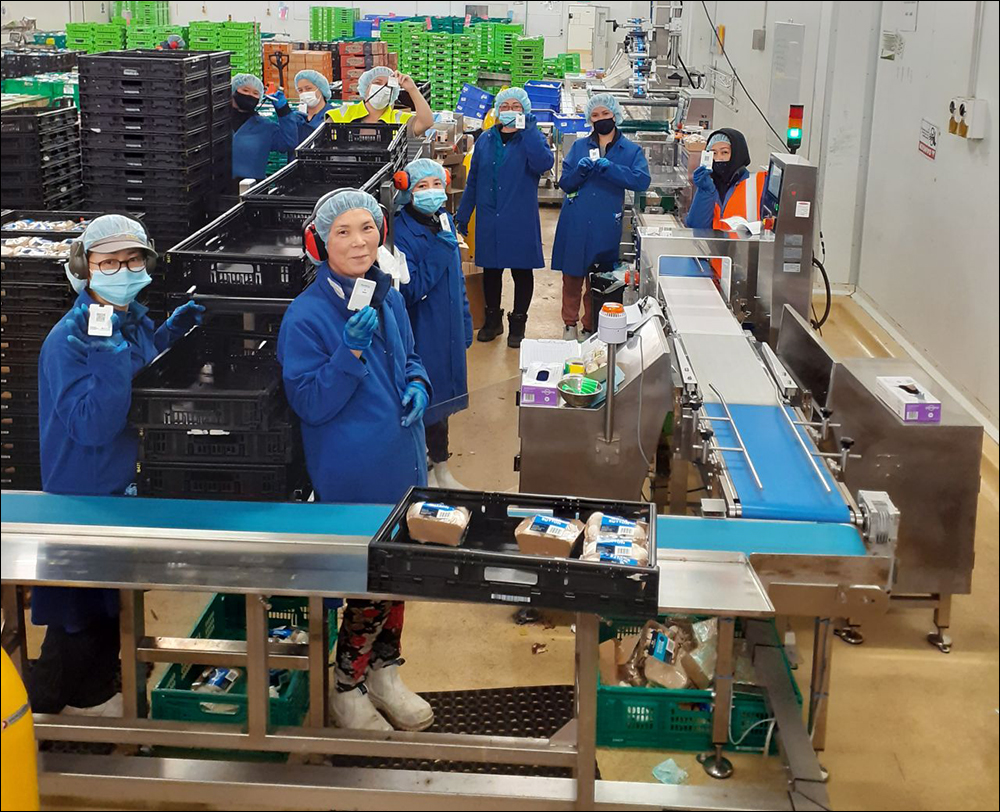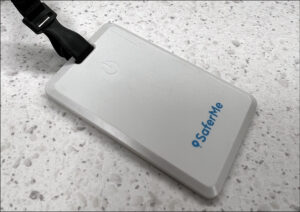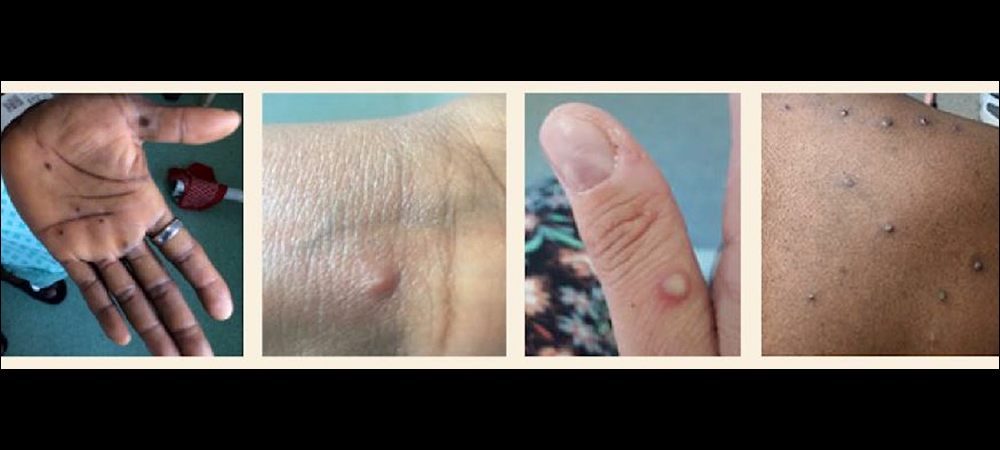- Disposable BLE Card Detects and Stores Anonymous Contacts
- Reporting Exposure with the Push of a Button
- Random Cycling of Encrypted ID Numbers
When the COVID-19 pandemic caused workplaces to shut down in early 2020, technology companies began to respond with new contact-tracing and proximity-detection solutions to keep workers safe in offices or industrial settings. SaferMe, located in Austin, Texas, was well positioned to serve this market demand since it already offered a proximity-detection system for worker safety.
As the pandemic has evolved, and as other infections have surfaced, the company is now expanding its offering to meet what some see as the latest potential threat: monkeypox. Although the Centers for Disease Control and Prevention reports that monkeypox is transmitted most frequently through close sexual contact, SaferMe says transmission via respiratory droplets also provides concerns for worker safety. Its customers have shown an interest in effectively addressing any potential exposures without overreacting by shutting down operations or isolating those not at risk.

Examples of monkeypox infections
SaferMe has thus released a new version of its Bluetooth Low Energy (BLE)-enabled contact-tracing card, software and mobile application, designed to be flexible enough to meet the challenges of this latest disease. The system is intended to detect contacts and provide traceability in the case of a monkeypox outbreak within a company, says Clint Van Marrewijk, SaferMe’s founder and CEO. SaferMe’s proximity cards—small, disposable devices that can fit in a pocket or be worn on a person—are built to capture and store accurate information about contacts between workers.
The collected data, van Marrewijk says, helps to ensure that companies do not overreact when they identify a case, such as by isolating too many workers or shutting down operations when it isn’t necessary to do so. Accurate data enables an accurate response, he explains, by identifying the most at-risk people and minimizing the likelihood of false contacts being traced. That, according to van Marrewijk, was found to be a challenge during the initial stages of COVID-19, but it can be avoided with monkeypox or other new infections.
Disposable BLE Card Detects and Stores Anonymous Contacts

Clint van Marrewijk
Each card, which comes with a built-in BLE chip and battery, can transmit and receive signals from other cards within its vicinity. Companies can adjust the settings to determine the distance at which they consider information worth capturing, as well as the minimum amount of contact time. The closest distance measured is 6 feet, which indicates that direct face-to-face contact has occurred, while the maximum distance is 50 feet. After 21 days, any contact data stored on the card is automatically deleted.
SaferMe provides its contact-tracing technology to companies in 30 countries, van Marrewijk says. One customer is the New Zealand government, and numerous businesses in the United States and beyond are employing the system as well for COVID-based contact tracing. “Proximity safety has been our specialty for quite a while,” he says. Initially, the solution identified the locations of people for safety purposes, such as when they may be approaching a hazardous area—a mine shaft, for example, or a dangerous object. It captures location data from its sensors and can issue an alert if necessary.
This solution is still in use among the company’s customers. “We had a lot of that sort of proximity-based alerting technology already built,” van Marrewijk states, “and then, when COVID started, we saw our own clients starting to use [the system] for contact tracing.” Similar to how safety-based proximity solutions work, individuals wearing the Bluetooth-enabled card for contact tracing are not personally identified, though an appointed HR office can maintain a record of the individual linked to each card’s ID.

Reporting Exposure with the Push of a Button
If a worker tests positive for COVID-19, they would report that status to management and push a button on their card. At that point, the card’s data would be transferred to their smartphone or tablet device via Bluetooth, and a human resources manager could view that information instantly, filtering details to identify any other cards detected in that person’s vicinity within a specified span of time—the previous two weeks, for example.
That allows an organization to take immediate action, van Marrewijk explains, rather than having to conduct phone-tree-based contact tracing, which has not always been entirely effective. The card is typically worn on a belt clip, lanyard or armband, and the data is stored only on the card unless an incident occurs, though some companies are choosing to synch the card data at regular intervals. The system is being used in schools and universities as well, and the technology can be built into existing ID cards.
However, van Marrewijk says, SaferMe has a larger vision for its solution than simply serving users during the COVID-19 pandemic. “Some of the [development] work we’ve done is to make the product really relevant to multiple diseases,” he states, so the system can be adjusted according to the transmission characteristics of a particular disease. Response to monkeypox, similar to the early days of the COVID-19 outbreak, has not always been appropriate to the actual risk, the company notes. “Therefore, in some cases you’re shutting down a whole site” or a whole department within a company, which impacts management and personnel alike.
Random Cycling of Encrypted ID Numbers
The card comes with a rolling set of IDs, van Marrewijk says, which alternate every 15 minutes. All data exchanged between the cards during synchronization and processing is encrypted using the AES-128 standard or better, including the use of rolling ID keys. To further increase privacy, he explains, only a client’s authorized users, such as human resources managers, can view contact-tracing data on the SaferMe system. The solution can store surface contacts based on an individual’s location, as long as users scan QR codes mounted in meeting rooms, lunch areas and other locations.
 Businesses already using the contact-tracing technology for COVID-19 can add the monkeypox version to their existing system, while the contact information can be adjusted for a specific transmissible infection, as opposed to COVID. Users would indicate whether they tested positive for a particular virus, and if another strain of COVID or some other disease outbreak occurred, that could be added to the system as well, with its own settings, based on recommendations from health authorities.
Businesses already using the contact-tracing technology for COVID-19 can add the monkeypox version to their existing system, while the contact information can be adjusted for a specific transmissible infection, as opposed to COVID. Users would indicate whether they tested positive for a particular virus, and if another strain of COVID or some other disease outbreak occurred, that could be added to the system as well, with its own settings, based on recommendations from health authorities.
SaferMe designed the BLE cards, which have a shelf life of 18 months following delivery. Once activated, the company indicates, the cards are expected to operate for 1,300 hours, for at least six months, based on normal usage of 10 hours per day, five days per week. “We actually continue to think that proximity safety is going to be a key driver of improving safety of people at work,” van Marrewijk says, “so that means we are developing constantly in that area.”
If monkeypox proves to be a transmission concern in the future, van Marrewijk says, the solution is ready to address it, just as it is for other infections. “I would say that business continuity teams at large [companies] are looking at this now,” he states. “The exponential nature of the curve has some of these risk teams somewhat concerned.” When COVID-19 first led to numerous RFID and other contact-tracing technologies, the company watched competitors enter and, in some cases, leave the market. “We’re specialists in this area of proximity safety and always have been, so it was interesting to see the amount of newcomers come into the market and then disappear again.”
Key Takeaways:
- SaferMe, which first offered its technology for proximity detection for worker safety in hazardous areas, is now providing contact tracing for multiple diseases.
- Companies can track exposures to monkeypox, as well as COVID-19 and other future transmissible infections, based on health authority guidelines.


